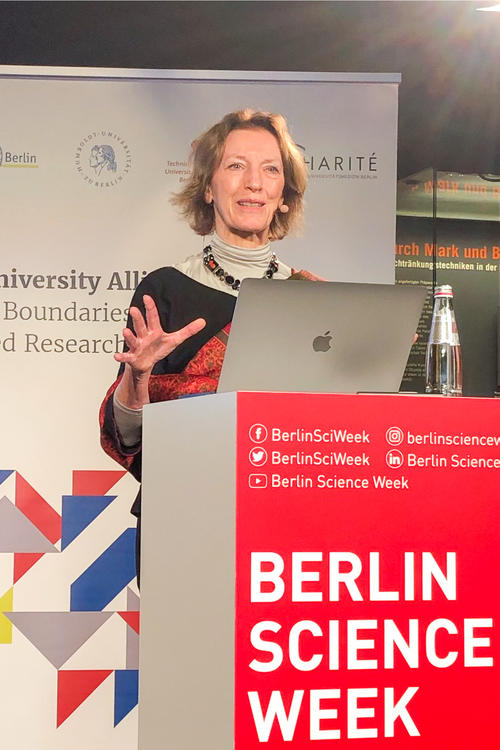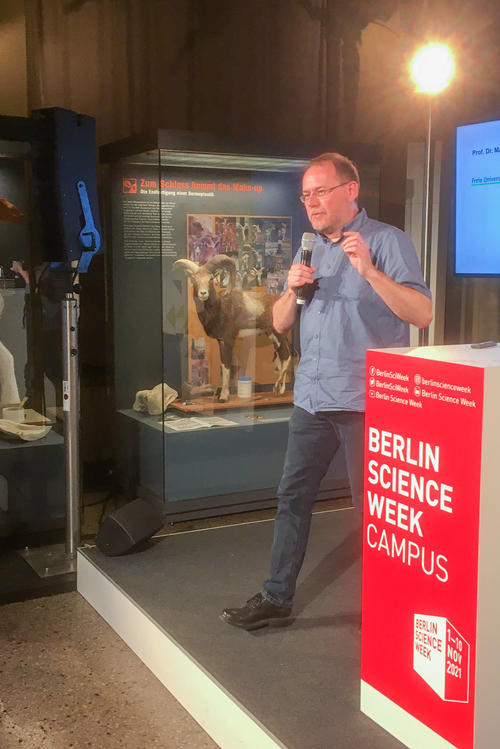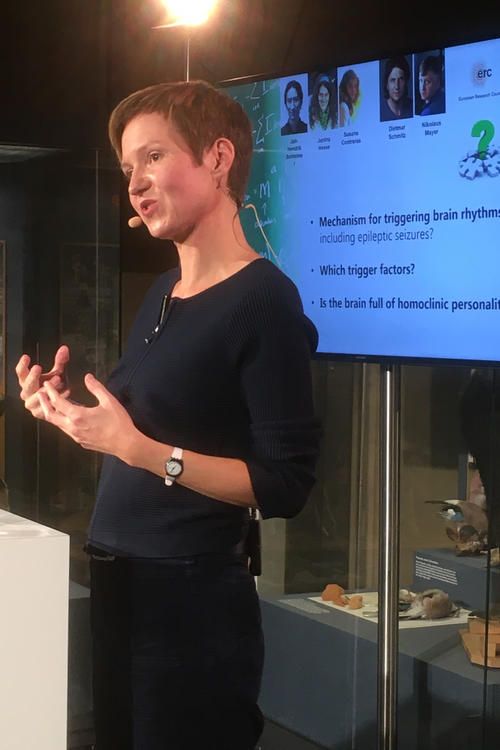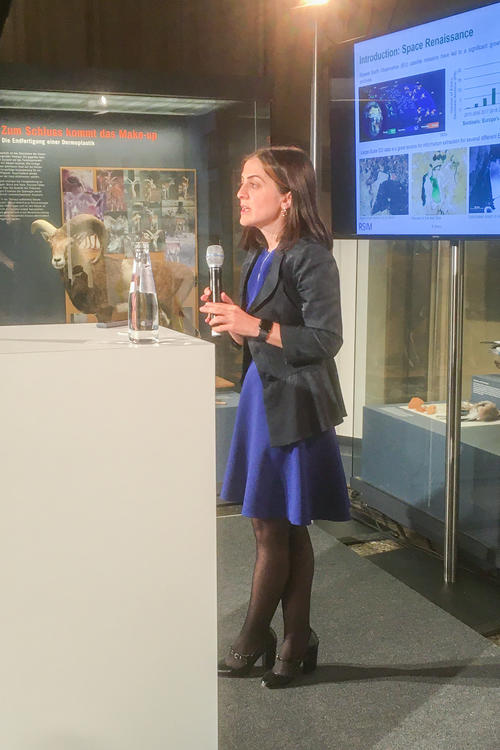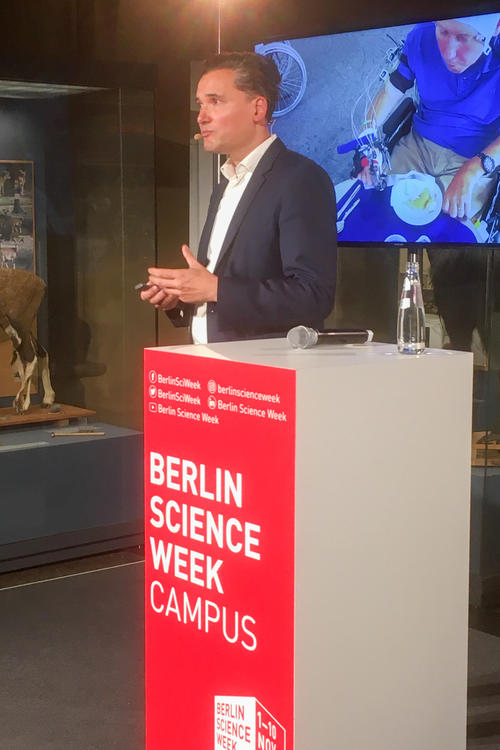The Transformative Impact of Science
The new president of the European Research Council, Maria Leptin, gave her first speech during Berlin Science Week
Dec 06, 2021
The Berlin University Alliance (BUA) and the European Research Council (ERC) invited to a special event as part of the Berlin Science Week. In an unusual and fascinating setting in the Polar Bear Room of the Berlin Museum of Natural History, Maria Leptin gave her first official address. Only a few days earlier she had assumed her new position as the President of the ERC. Four ERC-grantees from the BUA partners – Freie Universität Berlin, Humboldt-Universität Berlin, Technische Universität Berlin, Charité – Universitätsmedizin Berlin – then briefly presented their projects.
Sabine Kunst, spokeswoman for the BUA and president of the Humboldt-Universität zu Berlin, welcomed speakers and participants. She emphasized the eminent position of basic research and the prominent role that the European Research Council plays in its support. Basic research is also central to the universities' “third mission”, working with and for society, which must be emphasized again and again in this event as in many other places.
Prof. Dr. Maria Leptin, President of the European Research Council
Image Credit: European Research Council
Maria Leptin opened with the assertion, that science, as an attempt at understanding the world, is a worthwhile endeavour in itself. She pointed out, referring to the title of the session “the transformative impact of science”, that this understanding of the world enables us to change the world, and therefore transform our societies. In the past, this has above all brought about previously unimaginable wealth and technologies. But today, unlike in the beginnings of scientific and technological development, we also see the dangers emanating from the power that lies in understanding the world, and we need to accept and assume the responsibility that comes with power. Science being part of the solution to the problems we face today, is not limited to developing new technologies, but also encompasses the contribution of new ideas for the future of how we as humans want to and will live.
The president of the ERC insisted however, that the scientific endeavour can only flourish under conditions of freedom of inquiry, a tenet the European Research Council stands for. Independence of political guidance is not contradictory to contributions to solving the challenges of our time, as researchers share the concerns as well as the desires for solutions that drive politicians. Merely, freedom of inquiry ensures that our vision is not limited, not restricted, because solutions to problems can, like in the case of Covid, emerge from unexpected fields. In addition, new technologies and ideas always arise from a combination of previously developed understandings. This engenders, that the scientific venture is per se unpredictable and that in order to preserve the crucial contribution of curiosity driven research as well as a healthy research system, funding mechanisms need to respond accordingly.
To drive this point, Maria Leptin pointed out, the best advocates for fundamental science are the scientists that are funded by the ERC. Her full speech is available on the ERC website.
Four ERC-Grantees, illustrative for each of the four members of the Alliance, presented their projects in accessible, understandable and entertaining seven-minutes talks.
“Why we should talk about global change, not only about climate change.” Matthias C. Rillig
Prof. Dr. Matthias C. Rillig, Professor of biology at the Freie Universität Berlin and President of the Berlin-Brandenburg Institute of Advanced Biodiversity Research (BBIB)
Image Credit: Dr. Angelika Wilhelm-Rechmann
What soil bacteria can teach us about global change is what Professor of biology at the Freie Universität Berlin and President of the Berlin-Brandenburg Institute of Advanced Biodiversity Research (BBIB), Matthias C. Rillig, showcased in his talk. He showed and pointed out why we should think of global change rather than climate change. Nearly all research on soil bacteria works with only one or very few factors of influence. But in addition to temperature, we change the nitrogen content of soils, add microplastic and invasive species or a multitude of pollutants, to name but a few factors. So the question is, what happens when multiple factors are investigated?
Matthias Rillig had expected, that chaos would emanate from combining the multitude of possibilities in such multi-factorial comparisons, but no: a surprisingly straight-lined relationship in the results clearly showed: The more of the factors were active in the system, the more biodiversity was lost, the more soil ecosystem functions were lost. This is even more surprising, as each single factor could have positive, negative or no influence on soil systems. But combining them lead to a clear and cumulative decline.
While there is no proven scientific explanation available yet, he attempted to explained what happens in an imaginary human endeavour: writing a report to a deadline. A neighbour coming over with a bottle of wine to celebrate would be a positive event, having to respond to a question would be a neutral effect and having web-access-troubles would be a negative event. Yet, combined, all three will work towards your missing the deadline for the report. With the multitude of organisms active in soils, this is of course more complex, but the conclusion is still that we cannot afford to limit our vision to climate change but we need to talk about global change. And that more research, like this first 10-factor global change investigation, will be needed to find out how to restore the ecological function we are loosing.
“What happens, if nerve cells in the brain have different personalities?” Susanne Schreiber
Prof. Dr. rer. nat. Susanne Schreiber, Professor for Theoretical Neurophysiology at Humboldt-Universität zu Berlin
Image Credit: Dr. Angelika Wilhelm-Rechmann
The connections between nerve cells in the brain are key, but what, if these nerve cells have different personalities? This is the question Susanne Schreiber, Professor for Theoretical Neurophysiology at Humboldt-Universität zu Berlin discussed in her presentation. Accessible, empathetic people would communicate very different to choleric, uncaring people. In nerve cells, communication works per electrical pulses, and indeed science differentiates between what one could call “slow starters”– that react when triggered with only a few pulses, “jump starters”, who jump into intense firing when triggered and “it depends starters” somewhat between the two.
These latter ones are also called “homoclinic” and are the focus of Susanne Schreiber’s research. Using mathematics, she predicts, that these homoclinic nerve cells must be at work in the brain. Their speciality is, that they are especially good at immediately listening to other nerve cells – once triggered, they fire immediately and intensely, slowly fading, while the other cells take time to come up to speed and then fade again.
Why is this interesting? In a network, homoclinic cells show a synchronised activity, whereas the other cells show disordered activity. And this can be seen in EEG brain rhythm signals. Furthermore, nerve cells can actually switch into homoclinic cells for example by increasing the temperature, which then gives rise to highly rhythmic brain activities. Which is the link to why this knowledge is not only fascinating, but also practically important: because these rhythmic brain activities are often connected to brain diseases like epilepsy.
“How can multimodal, heterogeneous remote sensing data be queried and indexed?” Begüm Demir
Begüm Demir, Professor at the Institute of Computer Engineering and Microelectronics at Technische Universität Berlin
Image Credit: Dr. Angelika Wilhelm-Rechmann
How can Big data on earth observation be managed and machine learning be used to better use the exploding wealth of data, that are made available by satellites and remote sensing? This is the investigation lead by Begüm Demir, Professor at the Institute of Computer Engineering and Microelectronics at Technische Universität Berlin, in her “BigEarth” project.
Analysing satellite images can provide crucial information for diverse applications, for example monitoring the health of our planet like monitoring the health of forests. The data are already available in remote sensing databases, but to make them really useable, scalable approaches to handle the complex content of multimodal heterogeneous archives data are needed. In “Big Earth” Begüm Demir develops a search engine, that can do exactly that: operate on the semantic content of the satellite data. Before “Big Earth”, such queries were based on key words only, not on the semantic content of the satellite data. This new approach is already being deployed, especially in the European Space Agency, changing the current paradigm.
To have access to training data for the machine learning, Begüm Demir developed “BigEarthNet”, a large scale sentinel archive, that includes data from 10 European countries. It is publicly available and has been downloaded by various prestigious organisations in the two years since its release. Also, she has developed the “Big Earth Net Portal”, a portal that allows users to interactively visualise the datasets and discover the BigEarthNet.
“Patients cannot be asked to be depressed or to stop it.” Surjo Soekadar
Prof. Dr. med. Surjo Soekadar, Head of research divison Translation and Neurotechnology at Charité – Universitätsmedizin Berlin
Image Credit: Dr. Angelika Wilhelm-Rechmann
How machines help people suffering from a disorder of the brain like dementia, multiple sclerosis or depression and anxiety is what Surjo Soekadar, Head of research divison Translation and Neurotechnology at Charité Universitätsmedizin Berlin demonstrated. Illustrating his words with several brief films he showed how next generation neurotechnologies will improve quality of life and restore brain functions. For example, micro-electrodes can already be implanted in the brain and then brain computer interfaces translate brain activity into control commands of a digital device.
Surjo Soekadar’s research however focuses on non-invasive approaches, that do not require surgical procedures. He used the example of a neural exo-skeleton that translates a patient’s brain activity to close their fingers and grasp an object, to the actual movement of their hands. Paralysed patients can hence go out into a restaurant and have a meal using fork and knife. Most surprisingly, in chronic stroke patients that were unable to move their fingers, after a period of daily training, some patients actually regained a measure of control over their fingers – which was associated with the brain reorganising itself: the corresponding brain activity was assumed in a different area of the brain.
Surjo Soekadar is confident, that other brain functions may be restored in the same way. Next-generation brain-computer-interfaces will be able to do the same for brain functions like memory formation, emotion regulation, or cognitive control. The challenge is however, that it is simple to ask a patient to move his hand or to stop it – but no patient can be asked to be depressed and to stop it. Using the latest generation of quantum sensors however, it may be possible to record brain activity millisecond by millisecond, then apply brain stimulation and investigate changes in brain function and behaviour. This science can provide a profound transformative effect on how brain disorders can be treated effectively and without side-effects.


